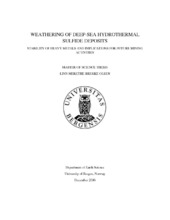| dc.description.abstract | During future mining operations on seafloor massive sulfide deposits, sulfidic material will be reworked and relocated at the seafloor, exposing the material to oxic conditions. In an oxic environment sulfidic material will weather through oxidation, a microbial catalyzed process that is well known from on-land mining activities to result in acidic conditions and increased solubility of heavy metals in the aquatic phase. However, few studies have addressed the role of microbial processes in weathering of deep-sea hydrothermal deposits, and how these processes affect the mobility of heavy metals in the marine environment. This study has investigated the mobility of heavy metals in the Loki's Castle hydrothermal mound and the background sediment by geochemical analysis of the solid material and extracted pore-water from two push cores, combined with microbial DNA analysis of the two materials. The mound material was anoxic, with pore-water concentrations of Zn, Cu and Pb in range of 7-29, 2-10, and 0-0.4 ppb, whilst the solid phase concentrations ranged from 2120-8030, 3920-6650 and 347-650 ppm, respectively. Solid phase concentrations were lower in the oxic background sediment, with Zn in range of 108-274 ppm, and Cu and Pb ranged from 81-686 and 23-178 ppm, whilst pore-water concentrations of Zn, Cu and Pb ranged from 4.6-37, 2.7-8 and 0-1.3 ppb. The heavy metals in the mound material are derived from mineral precipitated by seawater and hydrothermal fluid mixing, leading to precipitation of various metal bearing minerals, whilst the background sediment consists mainly of pelagic and glaci-marine sediment with a layer composed of hydrothermal fall out material. The microbial community in the mound material consisted of a high relative abundance of SO_4^2- reducers, Fe reducers and anaerobic sulfur oxidizers, whilst the background sediment had a high relative abundance of aerobic NH3 and NO2 oxidizers. The heavy metal concentrations in pore-water from the anoxic mound material were expected to be higher compared to the concentrations in the oxic background sediment, since the mound material had a higher heavy metal content in the solid phase, and the similar pore-water concentrations were therefore unexpected. The reduction of metal oxyhydroxides and the oxidation of sulfides release heavy metals to the pore-water, and the difference in relative mobility of the heavy metals in the two sediment cores is suggested to be related to the relative abundance of SO_4^2- reducing microorganisms in the mound material, which by producing H2S immobilize the heavy metals due to secondary precipitation of metal sulfides. The lack of SO_4^2- reducers in the background sediment show that the heavy metal concentrations must be controlled by other processes, possibly by adsorption to other minerals (clays and oxides) or concomitant precipitation of metal oxides. The exposure of sulfidic material to oxic conditions during mining activities will oxidize the sulfides and release the heavy metals to the aquatic phase, and since the process of immobilizing heavy metal seems to be less efficient in an oxic compared to an anoxic environment, an increase of heavy metals in the aquatic phase is expected to occur. | en_US |
